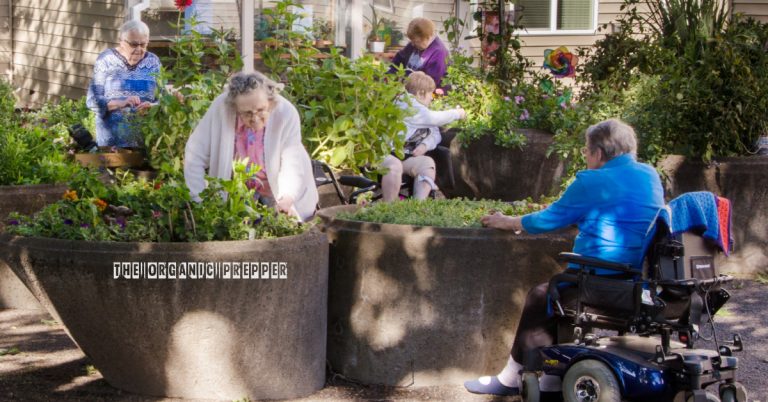by Amy Allen, The Organic Prepper:

Gardening is a very physical activity. Between planting, weeding, pruning, watering, and many other chores, it’s good exercise! It gets to be challenging when one factors in various kinds of disabilities, up to and including old age. That’s where adaptive gardening comes into play.
I learned about adaptive gardening the hard way.
I remember when my back went out in 2017. I had three slipped disks, two lumbar and one thoracic, one of which liked to hit a nerve when I was sleeping too well. In the first year, getting out of bed was a challenge!
TRUTH LIVES on at https://sgtreport.tv/
That’s the year I grabbed a field guide and my plant ID app and learned about my backyard. I had four pitiful pots of salad greens growing and that was it! I did, however, learn a great deal about the bounty I had under my nose. That was the year I joined the chronic pain club thanks to age and occupation-associated lumbar degeneration, and I was determined to continue gardening.
I didn’t know at the time that there was a name for this. I simply adapted and adjusted. The name for this kind of gardening is adaptive gardening, and the concept is pretty simple: make small changes in your habits to accommodate your new reality. Simple enough, right?
Also, be mindful of how you think. I worked on a book that year discussing motivational approaches to chronic pain, and the major takeaway was to guard my thinking. Studies quoted showed that people who focused on the pain tended to get worse and do less, whereas people who focused on doing the things they wanted to do were happier and did more. Yes, proper medications help, but I don’t allow myself to become dependent, either. I’ve been able to stick with OTC meds and add things like CBD.
A friend from the gun range has rheumatoid arthritis, and her hands are seriously messed up. And yet, she shoots competitively, often ending up ranked in the top ten. Because she adapted and guarded her thinking. My garden mentee last year was in a wheelchair, and she gardened. It CAN be done.
Adaptive gardening starts with planning.
How you go about this depends upon exactly what disability you have, but it starts with garden planning. In my case, I turned three of four raised beds into perennials, planting asparagus and strawberries that would come back every year. This cut down on the amount of planting I had to do. I also bought good knee pads, which help my back immensely! Two of those beds are still in perennial, but I can handle the extra work now as the discs healed.
Other gardeners use garden benches and sit while weeding. I lie on my side after a certain point. Another option is an elevated planter, which many gardeners with back problems find much easier to work with. Containers and flower boxes also help, and don’t forget your soaker hoses! Those are much easier to deal with than hauling buckets, especially if you’re in a wheelchair.
Get the right tools
If your hands are the problem, The Family Handyman has some tips for you! Starting with ergonomic gardening tools, which are designed to keep hands and wrists at a more natural angle for easier working. Cordless hedge trimmers keep electrical cords out of your way while ratchet pruning shears require much less hand strength.
The Ideas website also offers some cool tips. I’d never thought of retractable hanging baskets, but I have used containers on wheels and they’re so much easier to work with! The Backyard Garden Lover also shows some cool tools and garden configurations for people with disabilities.
Here are the concepts of adaptive gardening.
The common concepts of adaptive gardening shown in these references are these:
- Assess your situation to determine your garden plan. Are you dealing with arthritis, back problems, a wheelchair? What are the new rules?
- Make your garden space accessible. If you need wide paths, make them or have them made. Use raised beds, containers/containers on wheels, retractable hanging baskets, and elevated planters to put your space within reach.
- Ergonomic tools, extenders, and tools that require less hand strength can be very helpful! I love my knee pads. I know of a gardener who made a seeder from some PVC pipe and a collar. She drops the seed down the pipe into the furrow. The collar is attached 1 inch up and adjustable to what she’s planting, so the seed goes the correct depth. The collar also has a side arm to help her space her seed. This was made from materials she had around the house. Are there any materials you could use to make, or have made, the tools you need?
Don’t forget your mindset!
And remember above all things: keep a positive mind!
The benefits of gardening are many, especially for the disabled gardener. From the sense of accomplishment that comes from growing even some of your own food to the peace that comes with working in nature, there’s no way to beat gardening.
I’ve met some cool people and learned some new skills. Gardening can even help develop fine motor skills in some cases! I’ve found a great deal of purpose in gardening, and the exercise has helped me heal as much as I’m able.
And how about the taste of homegrown? Nothing beats it! So adapt, adjust, and garden!
What about you?
If you’re looking for more advice on how to have the most productive and efficient garden ever, check out our very popular Home Agriculture Comprehensive online course.
Have you ever had to change how you garden due to injury, illness, or age?
What adjustments have you had to make to overcome? What are your recommendations to others? How did you keep your mind in a good place?
Read More @ TheOrganicPrepper.ca



